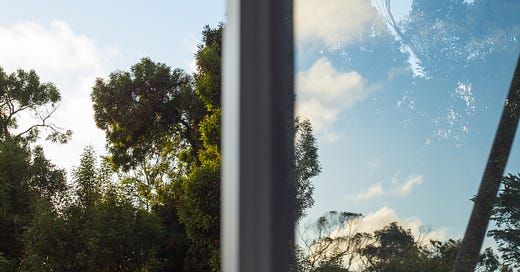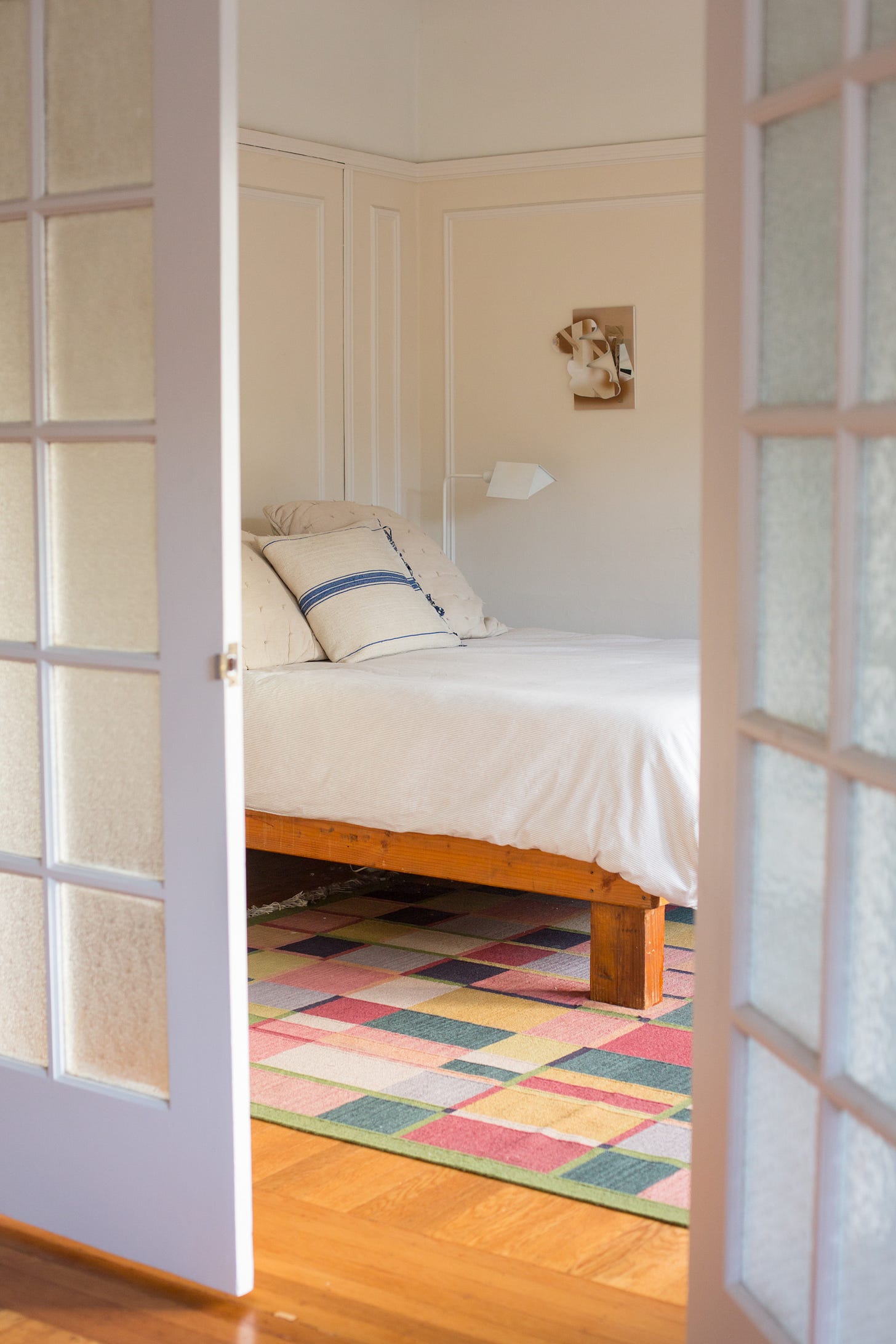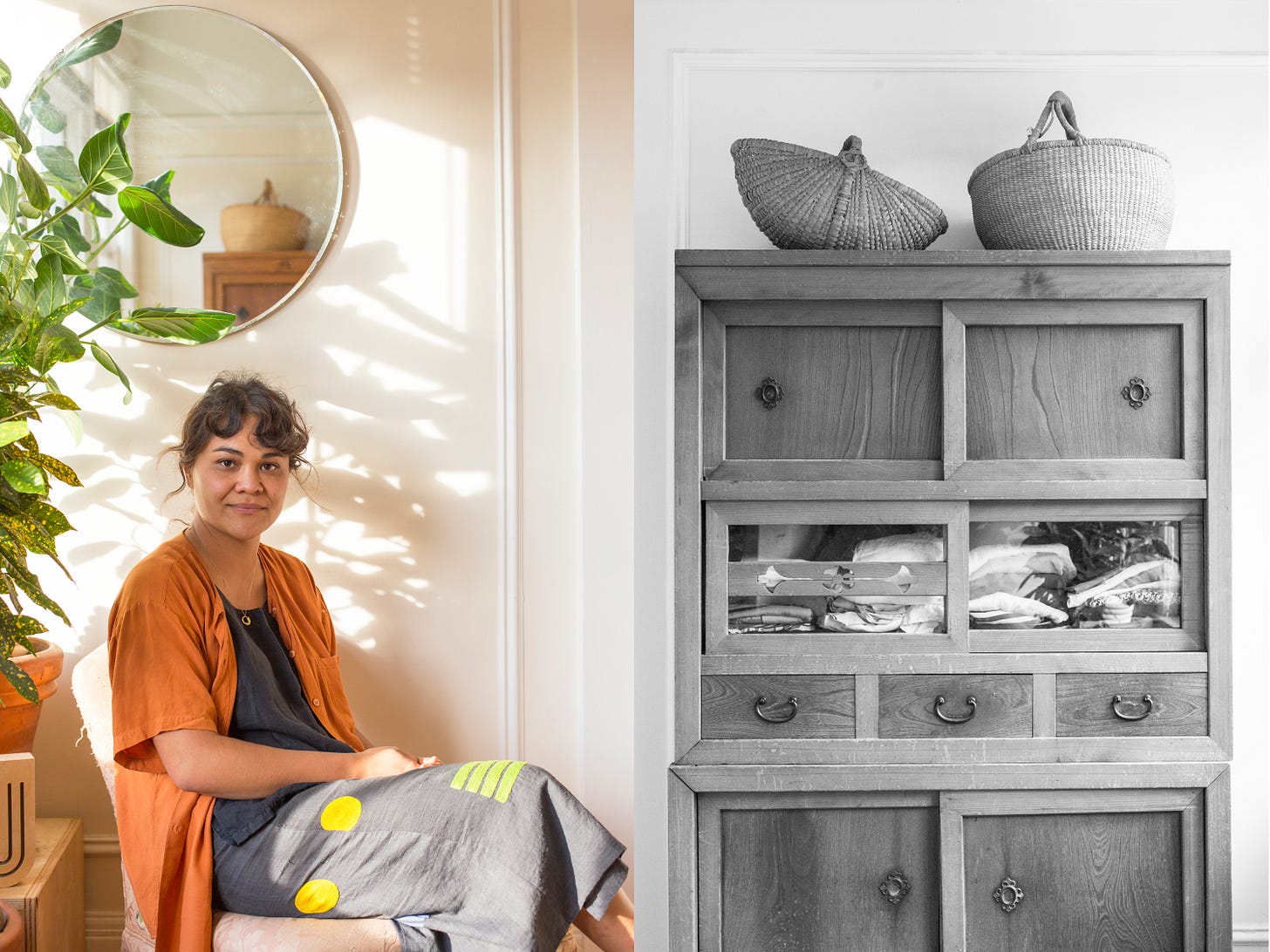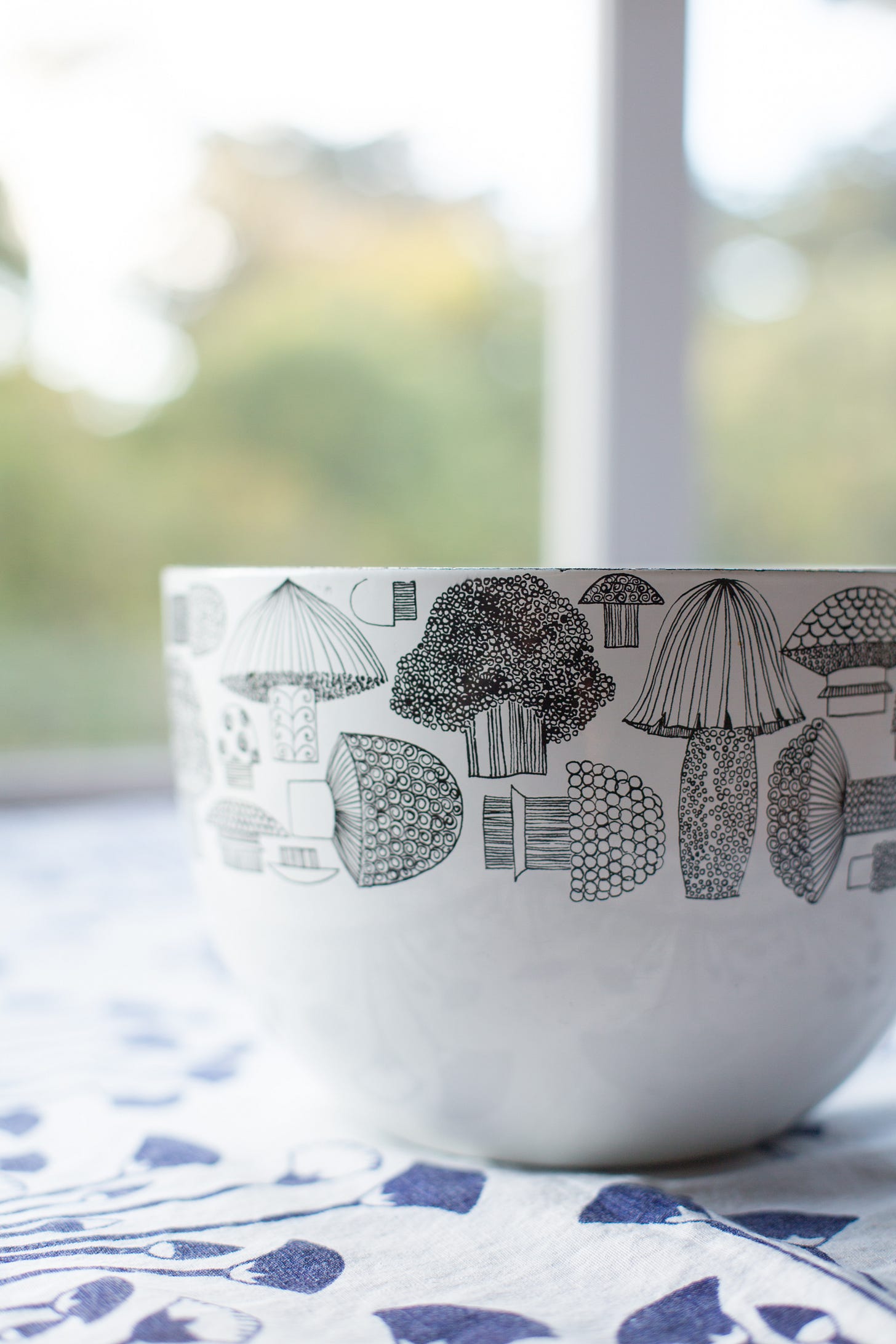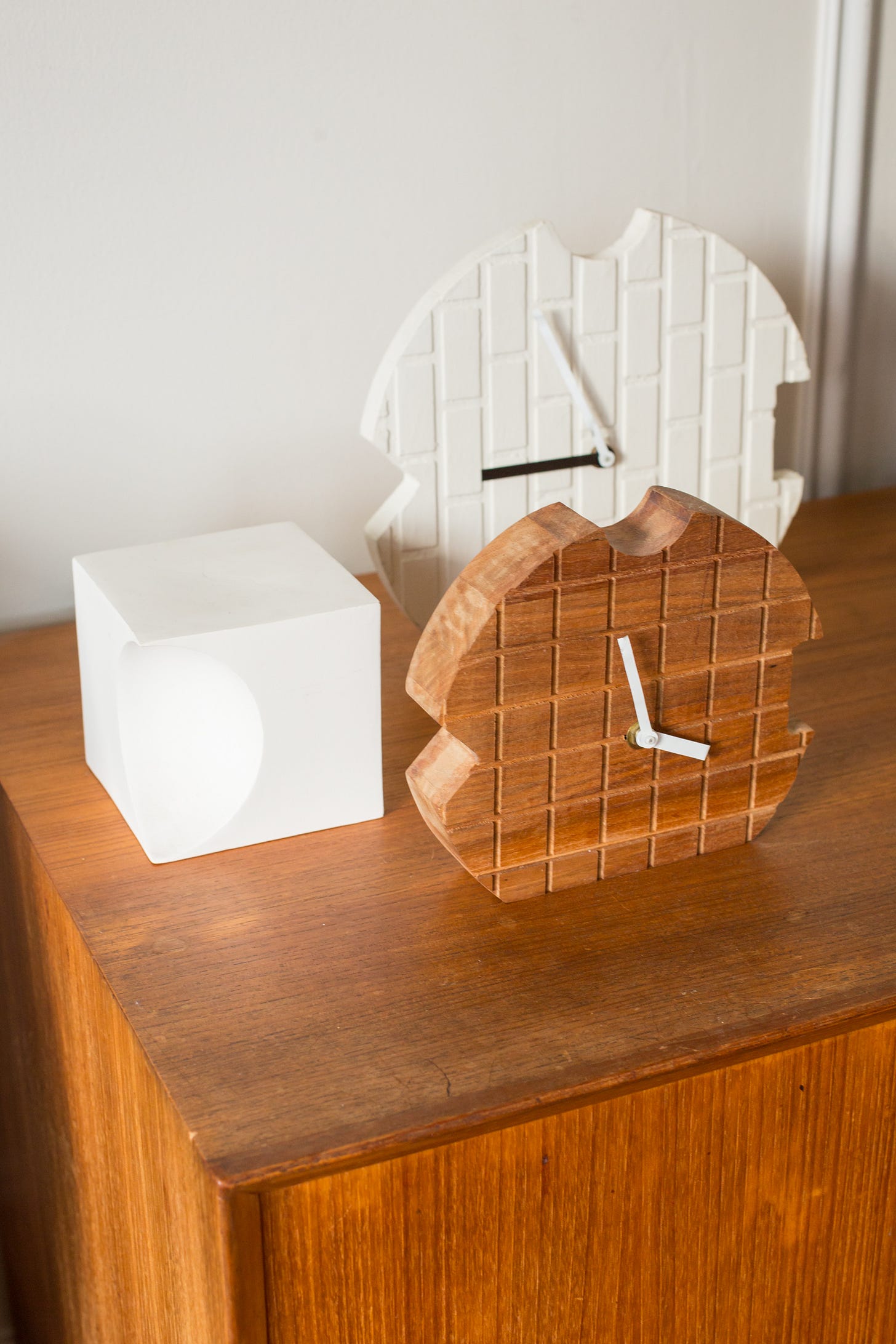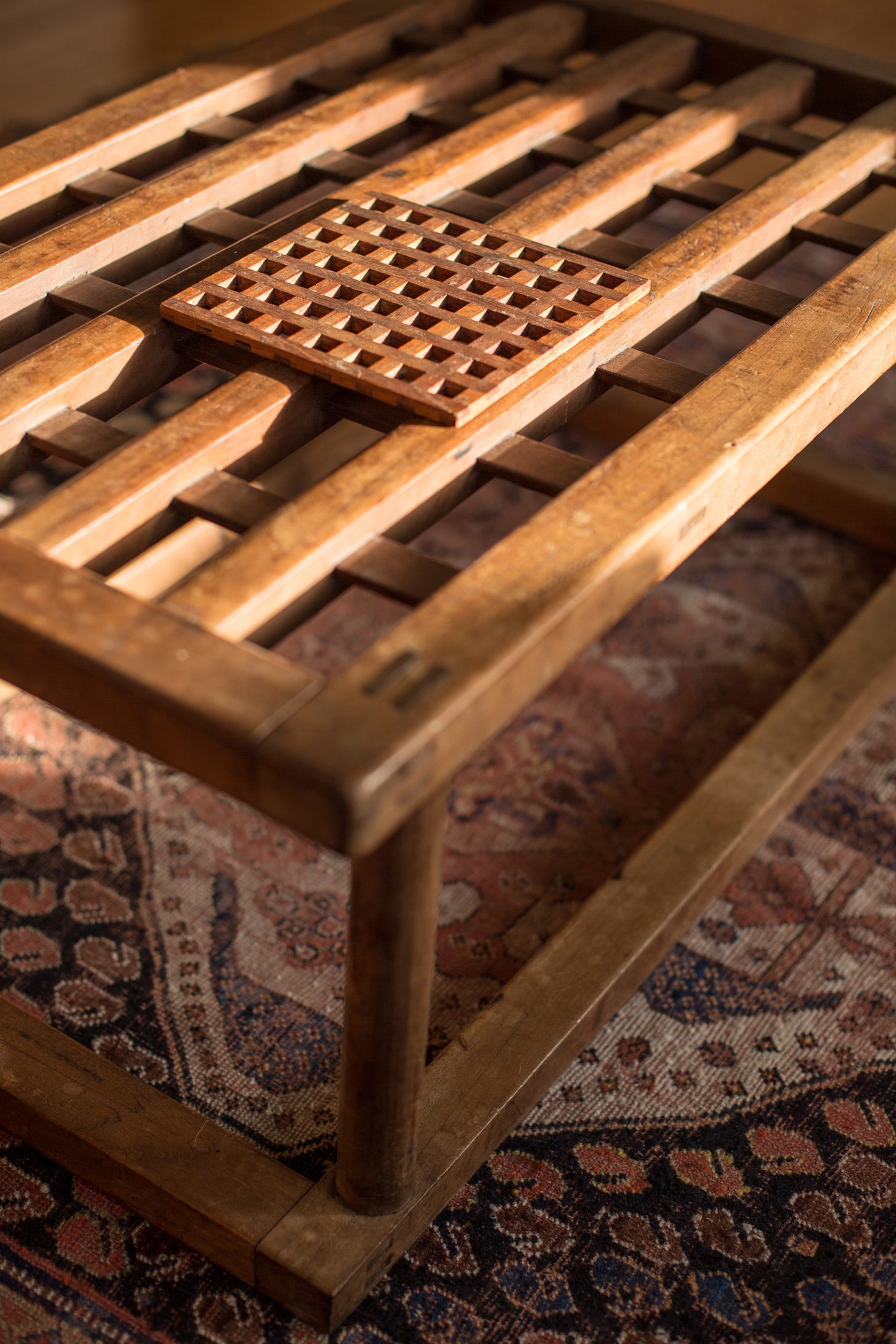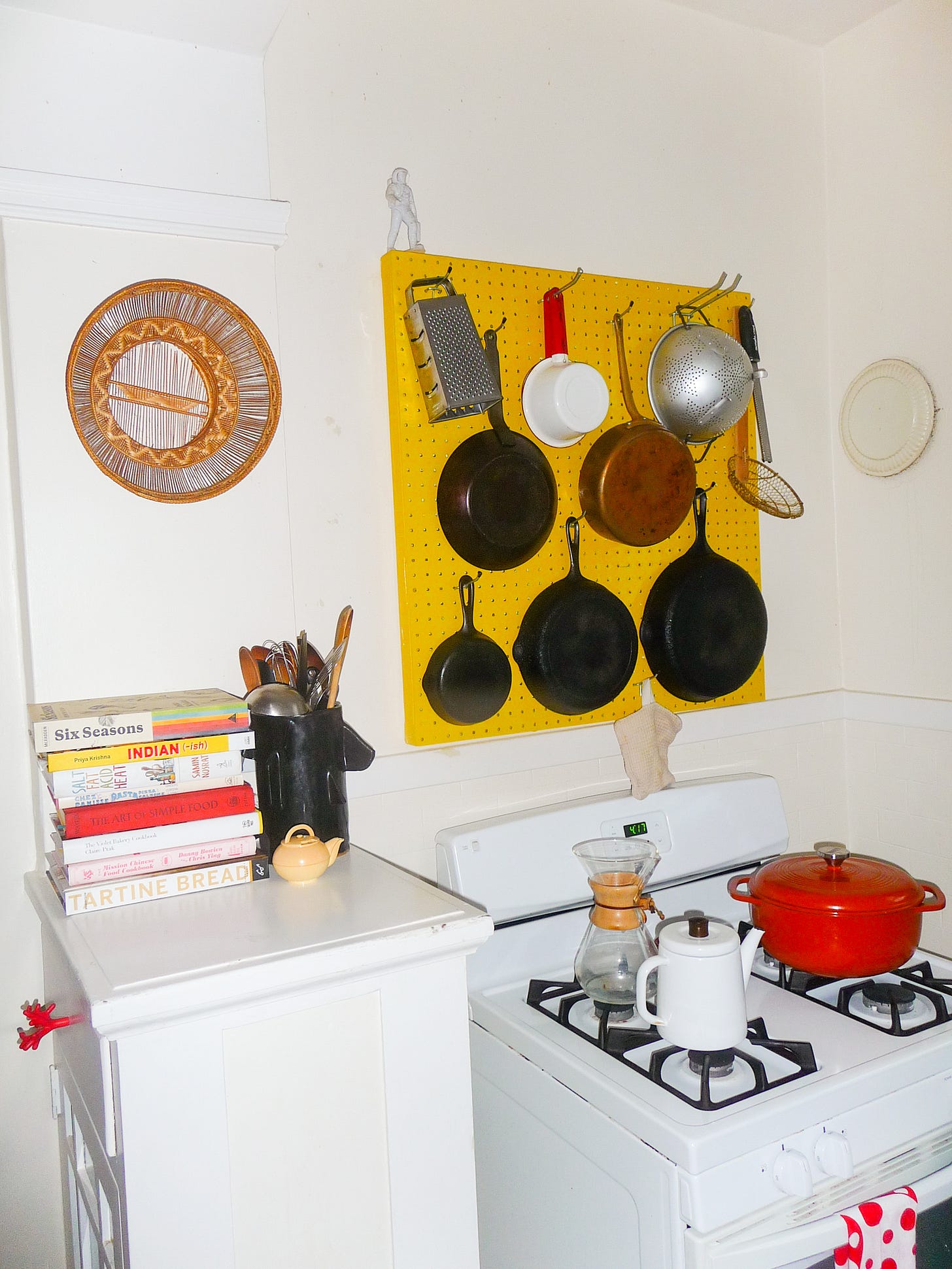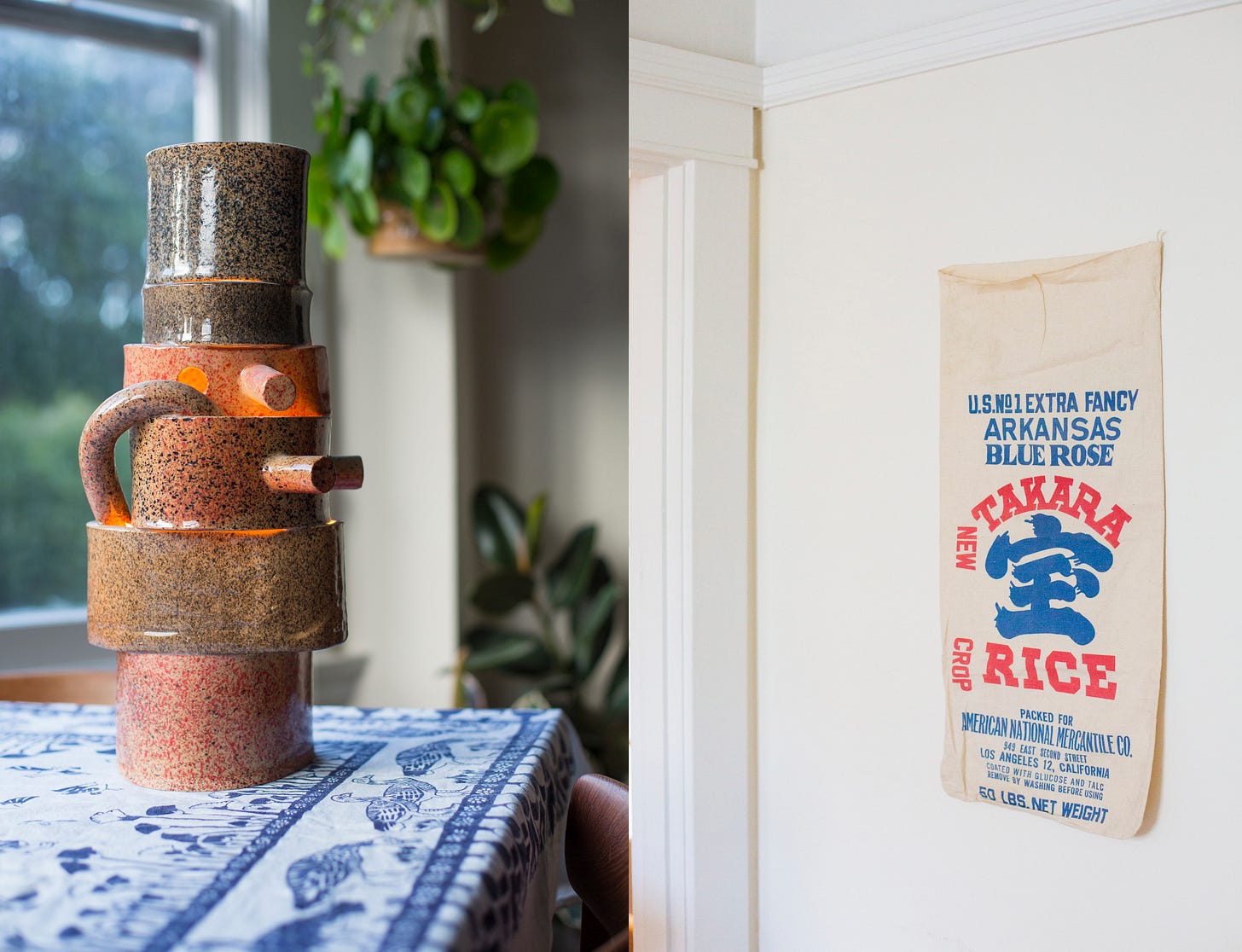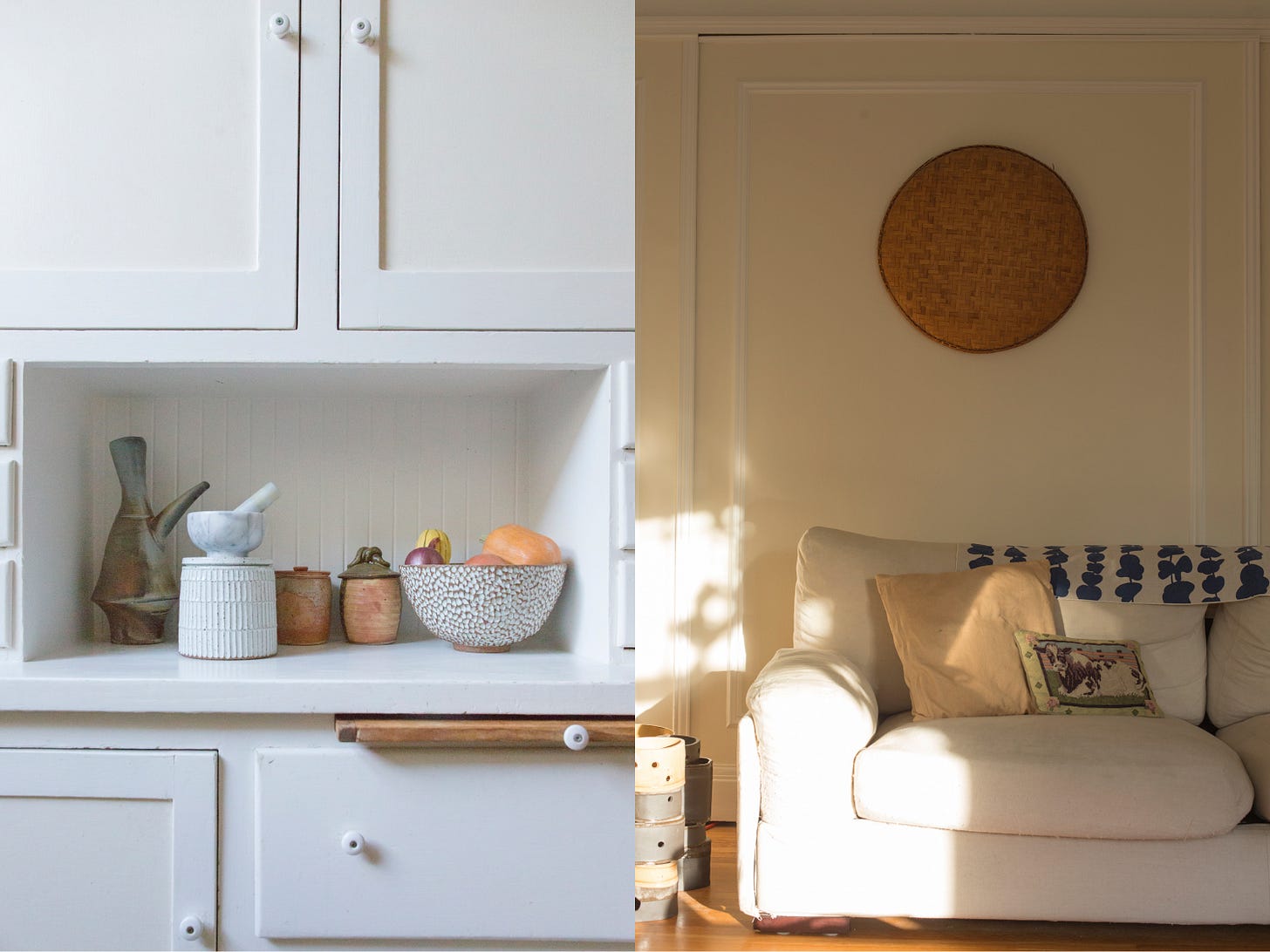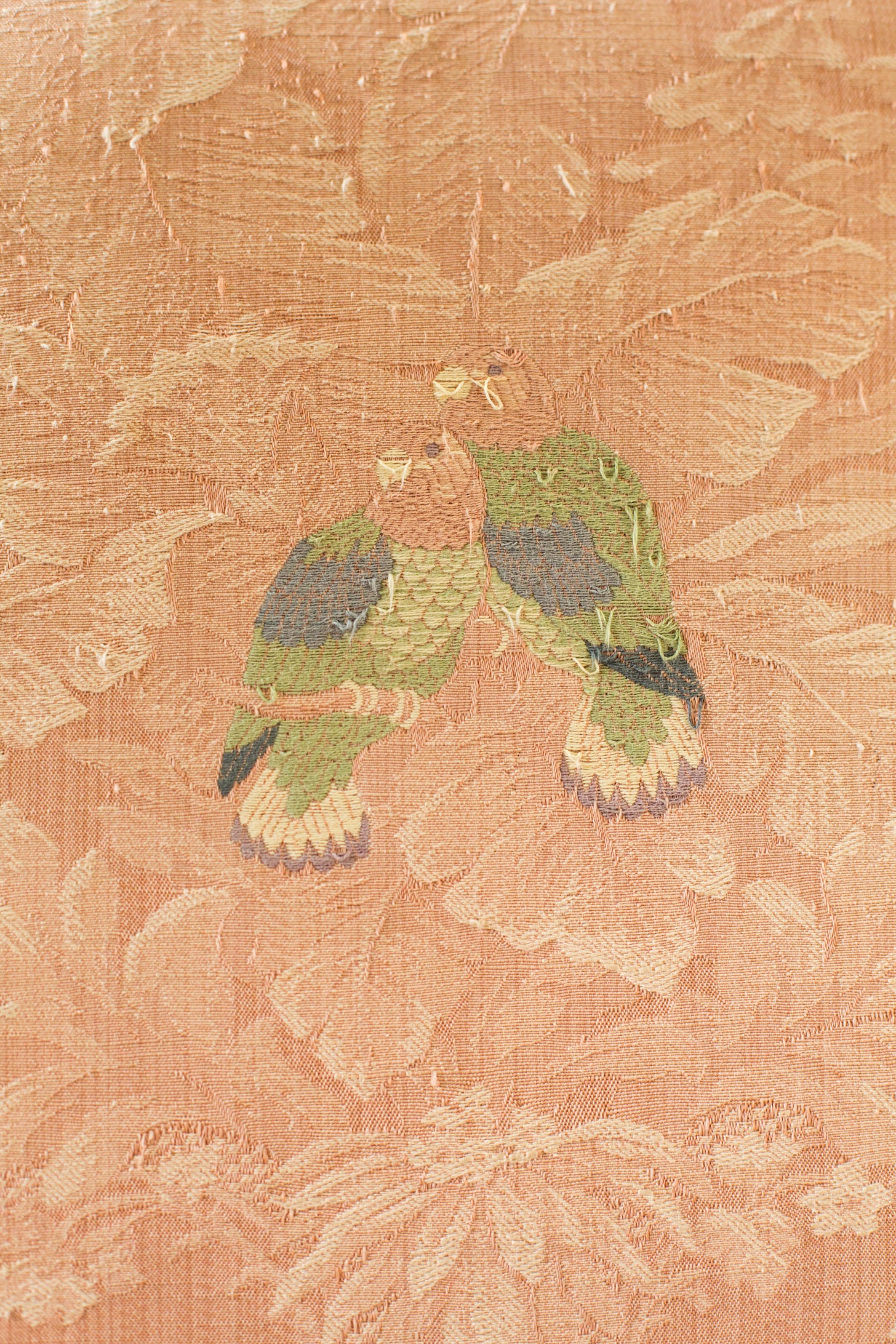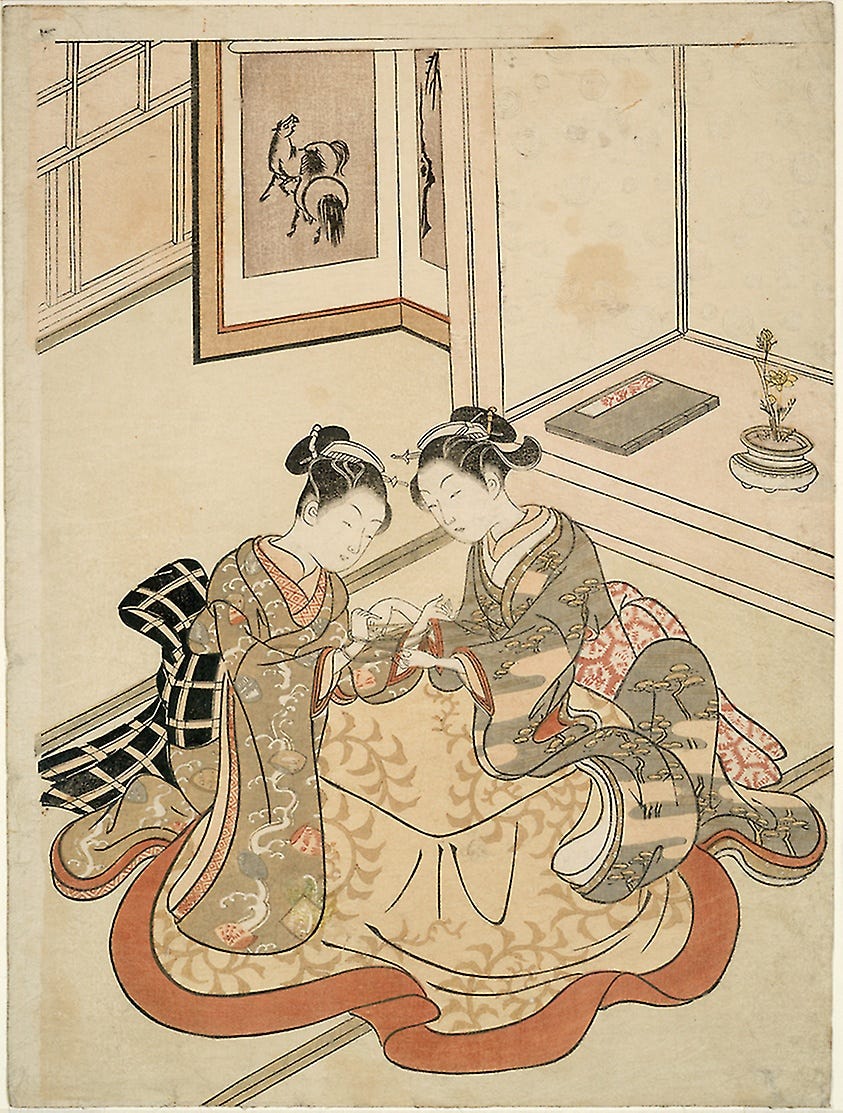At home in San Francisco, California with Steffi Morrison and Trevor Goosen
"Things must either have a high utility or an emotional value."-Trevor Goosen
Good morning.
Peeking into the San Francisco home of my friends Trevor and Steffi got me musing on the multiple lives of objects, on unintentional minimalism, and how we chose what we live with. Their approach, inspired by frequent moves, is: consider the weight of your collection; live with art made by friends; choose frequently used objects or those with dual purposes; prioritize items with emotional value, especially those gifted by loved ones. Everything else? Hold onto it loosely, if at all.
Trevor Goosen is a fabricator and artist working with ceramic and wood. He often powers his creations into subtle sources of light or time-telling. These lamps and clocks, as well as Trevor’s sculptures and two-dimensional images, reveal affinities for geometry and order as much as for cheekily sensorial visual romps. His work employs both old-tech (Rube Goldberg-like contraptions, plywood, clay) and new-tech (graphic, xerox-y copies, pixels). These days, he teaches sculpture at Cornish University to students that are surely, as I am, delighted by his playfulness, wit and warmth.
Steffi Morrison is a Berkeley-raised arts facilitator whose work involves caring for archaeological, historical, and art collections. At the Presidio Museum, she developed exhibitions, telling stories through historical objects and ephemera left behind by prior occupants of the land. At present she works at ArtsFund, helping grants and artists meet. She studies the meaning of objects professionally yet manages not to fill her life with many of them. Moving often for both school and work, Steffi and Trevor currently live in Seattle for the second time; previously they lived in San Francisco, where I photographed their home for REALM.
Airyka: Hello! Can you describe your home-aesthetic in 3 words or phrases?
Steffi: Wooden Waldorf school toys. Kyoto hotel lobby.
Trevor: Granny goes to the club.
I love that description: it embodies your simple, playful, spare, old meets new approach, but you just said it far more creatively. So, can you tell me a little about where you live?
Steffi: We live in a 1926 apartment in San Francisco in a post-1906 earthquake, spec-built Edwardian-era flat in the Richmond District. I like to try to imagine this area pre-colonization, with its rolling sand dunes and scrubby vegetation.
Do you consider yourselves minimalists?
Trevor: I don’t. I feel like we have so much stuff: four bicycles, loads of camping equipment, two cats.
Steffi: If being minimal means being sensitive to clutter and vacuuming constantly, then I am a minimalist.
What’s your most beloved object at home?
Steffi: My tansu, a wooden mobile cabinet. It was the first piece of furniture I was given by my mom when I moved here. Its sliding doors (instead of pull drawers) have changed how we organize our clothes. It’s easier to see your belongings, and therefore harder to squirrel things away.
How do you select the items you live with, especially since you live with so few?
Steffi: A mishmash of things have made their way into our home: Trevor’s ceramic lamps, well-worn furniture passed down from grandparents, and bric-a-brac from Oakland Museum’s White Elephant Sale where my mom has volunteered for years. I cherish second-hand goods like a Kaj Franck enameled metal mushroom bowl, a late 19th century Persian rug, and an eggplant-shaped vase. We select things that seem to be friends with another object, like Zoe Dering’s ceramic bowl next to Kay Coffee’s garlic container.
How attached are you to your objects?
Trevor: We’re very attached to our belongings after many moves, up many staircases. Our things must either have a high utility or an emotional value.
Steffi: Typically, I feel very unsentimental about the things I’ve purchased for myself, however anything I inherit or am gifted by someone dear, I will keep forever!
What are the most important factors to you when finding a home? I know you’ve had to re-find home again and again, moving so often for work, school and life-changes.
Steffi: Before the pandemic, proximity to public transportation and the library was central, but having outdoor space is important now. I will always love the wooden floors, bay windows, and wonky built-ins of San Francisco apartments.
If you could grab only a few belongings in a fire, what would those be?
Trevor: I would somehow grab my Danish Modern dinner table and its seven chairs, which my paternal grandparents used daily for over fifty years.
Steffi: After the important documents and our animals, I’d grab my grandmother’s kotatsu, a low wooden table that we use as a coffee table. It would formally have been covered by a futon with a heat-source underneath. Quite cozy. I think these pieces embody the connection to our dearly departed family members.
What do you think homes of the future will be like?
Steffi: I feel more doomsday about this one. Homes of the future will have to be adaptive to climate change: air filters, fire-safe materials, and energy-efficient water fixtures.
What items in your home would you pass along as heirlooms to your future-child?
Trevor: Art created by friends over the years: Kate Bonner’s wall sculpture, Luke Armistead’s rainbow plant holder, Rachel Wexler’s metalwork.
Steffi: Our collection of woven baskets and trays from Trevor’s grandmother—her kitchen was filled with them—functional and beautiful.
What do you consider the most luxurious thing about where you live that you wouldn’t be able to take with you if you relocated?
Steffi: Our neighborhood is bound by the ocean to the west, the bridge to the north, and Golden Gate Park to the south. Access to these natural features is an immense luxury that we couldn’t pack up with us.
What element or aspect is most meaningful to you about your current home?
Trevor: The view from our west-facing windows looks out onto a greenway that runs along Park Presidio Boulevard.
Steffi: I didn’t realize seeing the tall cypress trees or hearing hawks in the morning would be so nice.
Do you collect anything in particular and how did that collection begin?
Trevor: Spices. It started after eating at Chaat House and buying goods from ‘India Supermarket’ next door in Bellevue, Washington.
What’s the best advice you ever received on how to cohabitate with another person?
Trevor: Cook together.
Describe your home in 5 phrases or words.
Tree tops, sunny afternoons, foggy, noisy, cat-friendly.
Describe your dream home in 5 phrases or words.
Big kitchen, outdoor eating, studio space, vegetable garden, bees.
Delving Deeper: The Kotatsu & Double-Duty Design
When I saw a low, latticed table made of wood in Trevor and Steffi’s living room, I immediately asked about it’s provenance since it baffled me. Its surface was barely a surface—just a grid of square-shaped holes, a clue that it was not simply a coffee table but something repurposed, originally destined to serve a different function. This is how I learned about kotatsus: low structures with gridded frames, meant to be draped in thick fabric, with a heating unit—electric, today; charcoal, yesteryear—tucked below. One sits at a kotasu on the ground, not at a chair, tucking their lower half under the fabric, into a cocoon of enclosed, warm air.
The historical paintings and photographs I found of kotatsus were soft, languid and redolent of lounging. They looked like the object-spawns of a tidy table and a supple bed. However, the kotatsu came into existence in Japan’s 14th century when someone attached a seating platform to a traditional cooking stove, in pursuit of a warm place to perch. Meant to absorb the hearth’s heat and create the ultimate, cozy, kitchen hang, the warm seating eventually transformed into the object known as a kotatsu. Though separated from the kitchen in the end, the idea—a heat-emoting piece of furniture that would also beckon gathering—took form, and is still used around much of Asia today.
Similar inventions exist around the world: in Spain and Portugal there are braseros, in Tajikistan and Afghanistan the sandali, and in Iran, the korsi. In the Western world we have radiant-heat flooring (my all-time favorite heat-source) however, Korea invented their own kind of underfloor heating (called ondols) much earlier. Both ondols and the kotatsu prototype were fueled by the cooking hearth, the sole heat source within a home. Double-duty designs like these deserve more time in the spotlight in my opinion: not only are they energy saving but they can inspire similarly dual-purpose inventions that blend ingenuity and resourcefulness in our domestic spaces.
It’s worth noting the mutuality between clothing and furniture design when the kotasu was invented. Kimonos were worn in 14th Century Japan so when seated at a kotatsu, one could easily tuck their legs under the table’s heavy blanket-topper. Warm air could move freely against the skin, flow up through the garment, and escape out the neck, in turn heating the whole body. Enveloped in a cloud of warmth in a brisk room—a poetic commingling of fashion and furniture design.
All of this reminds me about a tale of a resourceful mother who, before sending her child out the door on his icicle-laden walk to school every winter, prepared two hard-boiled eggs, one for each of his jacket’s pockets. Upon arriving to school the child not only had surprisingly warm hands after an icy walk, but breakfast, as well. Designs that work doubly like this, poignantly offer multiple points of nourishment, just as kotatsus, eggs, and mothers, tend to do.
Consider home
…a place to live with things both functional and nourishing, like the kotatsu, or hot, hard-boiled eggs in your coat pockets on a cold morning. As Trevor said, any items that make the cut for his and Steffi’s oft-moved residence are either highly utilitarian or have an emotional value. Stuff-related decisions become starry night-sky clear when you decide belongings belong if they have a clear use or a personal resonance. Ideally, they have both.
If items (anything not inherently part of the architecture) have no functionality, (this includes aesthetic joys, in my book) nor some kind of personal significance, what are we doing taking care of them? Why are we living with them every day? Consider giving away items that don’t offer ease of function, usefulness, or personal resonance.
Years ago, my older sister, Rebecca, began an online bulletin board of sorts to list usable but no-longer-wanted things (extra peaches/books/blankets/cast iron pans/what-have-you) to give away. It’s called Buy Nothing, as the exchange of money is prohibited. Today, Buy Nothing is a non-profit run by volunteers, and thriving on almost all the world’s continents. It encourages an economy of giving, rather than an economy of exchange, where one must already have something to warrant receiving. We were raised by strong willed, environmental-activist parents who near-constantly discussed the crimes (and boomerang effect) of things gone to waste unnecessarily. A lovely side-effect of giving things to actual people, rather than donating them to organizations, is the direct path, the lack of shipping and transit required, and the fact that you meet your neighbors in the process.
It’s exciting to recognize the many possible transformations of design over the centuries, and the multiple lives of objects given from one person to another. Imagine, too, the many incarnations of things that enhance one’s quality of life which are ultimately un-buyable, like clouds. A few weeks back The Daily podcast featured this essay by Jon Mooallem about The Cloud Appreciation Society. Mooallem argues for making more time for idle pleasures, even frivolity—for turning your attention to the ephemeral world. I love his writing for the way it reveals remarkable and overlooked subjects; his stories are a very pleasing blend of tender and amusing.
Etymology Interlude
Belongings: bee·laang·uhngz (noun). Movable, personal possessions connected to someone in particular.
Mid 14th Century. Early English, and prior to that, German origin.
Investigating this word induced such a rabbit hole tumble that I asked my father (Latin-expert, Scrabble-buff, word-collector) to help. Here’s what we learned:
The key to understanding the history of the word “belongings” is to appreciate how the prefix ‘be’ changes the meaning of a word from a verb to a noun, and refers to the completion of something. Thus, “be” in front of “longings” means that longings are completed (through attainment, in this case: what one has longed for, one now has, in the form of belongings). Want to dazzle? Find something bedazzled, and so on.
Curiously, obsolete meanings for 'belongings’ include ‘members of ones family,’ ‘an appendage,’ and ‘circumstance connected with a thing’. This goes to show that historically, our personal belongings or objects, can be as intimate to us as our family or our own body.
Longing (for something, some place, or someone) comes from the root word “long” which references both distance and duration; longing notes a long ways or time apart, a separation. Longing is felt in relation to the long distance or duration between ourselves and the thing/place/person we long for.
Which of your belongings would you long for, if you did not feel you belonged in the place you were? Do any of your belongings shorten the distance between you and that which you long for? Do you consider things that belonged to someone else before you, truly yours? Do you think about where your belongings will end up when you’re gone? Who will you will your belongings to? Why do your belongings belong with you, anyway?
What do you long for, now?
Until next time,
Airyka


